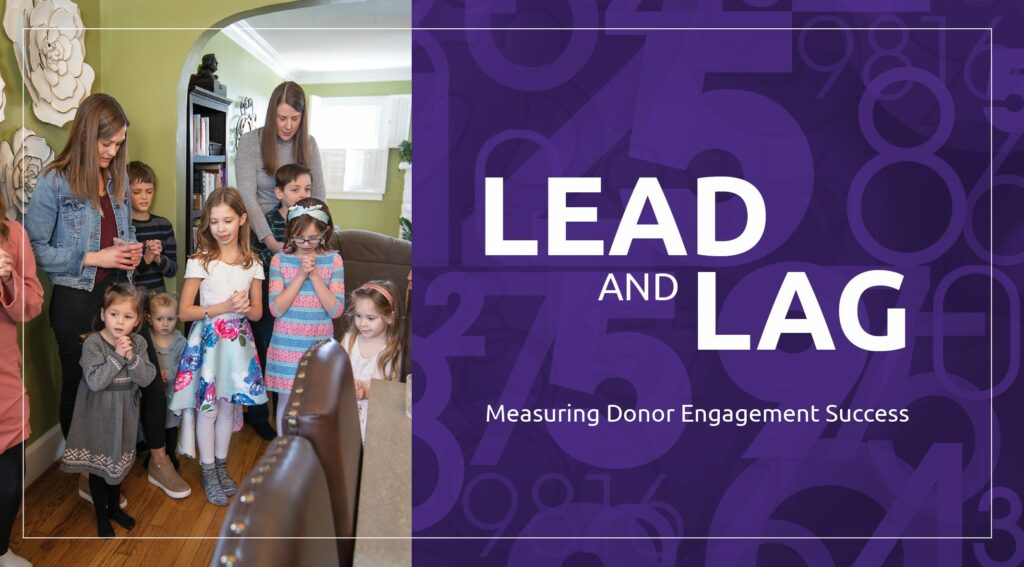Lead and Lag: Measuring Donor Engagement Success
Share


How much money did your ministry raise from donors last year? Did you hit your goal? Did you have a goal? If you raised more than you expected, why? If you raised less than you expected, why?
Lag
These questions aren’t about the total dollars raised by your ministry last year. They are questions about measurement. Dollars raised is a measure that all ministries use to determine if their donor relations are successful. More pointedly, money raised is used to decide if a development director should keep his job. And it is a wholly insufficient measure of success. That’s because the amount of money donated to your ministry is a lag measure. The final score of a sports game is a lag measure. It tells you how the game ended but doesn’t tell you what happened to arrive at that score.
Lead
The activity leading to a final score can be considered a lead measure because they are the moment-by-moment actions that result in and lead to the final score. A great coach will know which actions to take in every situation to increase the likelihood of success. When should you run? When should you pass? How does that change with inclement weather? Indoor stadium? Outdoor stadium? Who is your opponent? There are coaches who will tell you that a game with a winning score was poorly played or that a losing score isn’t a good reflection of the effort on the field.
Ministries often pay little or no attention to lead measures. Yet, these are the only measures you can really control. Properly understood, lead measures give you real time feedback on the job performance of your donor development team. Even when it’s just one person. Since the number one predictor of generosity is relationships (see our January article), lead measures are largely relational activities. Here are some key lead measures Lutheran Church Extension Fund (LCEF) uses when coaching donor relations:
- The number of in-person visits per week
(for a full-time development director, the target is five.) - The number of daily donor touches
(email, phone call, text, social media DM, handwritten note, etc.; the daily goal is ten). - The number of networking meetings
(getting in front of new audiences should happen an average of once per month).
You can see how lead measures are easily trackable in real time. An Executive Director can quickly assess performance on lead measures with a few simple questions (see below). But it’s not just about quantity; quality is also a factor. The number of unique visits, as well as many donors and prospects, are seen as possible. The purpose of visits, such as cultivating new relationships, stewarding current relationships or soliciting a gift. Touches strengthen the relational connection with donors, keeping your ministry top of mind. It is statistically proven that engaging in the right mix of lead measures results in increased giving. In other words, when you put in the time to build relationships, the money follows. It follows predictably, allowing you to more accurately project future giving and build budgets on real numbers and hard data. If you’re not doing development work full time, reduce the lead measure weekly goals accordingly.
Tracking Performance
Even better, an executive director can easily measure performance on a weekly basis with a brief check-in and a few simple questions:
- How many visits are scheduled this week?
- How many visits were made last week?
- What kind of visits were they?
- Cultivation (How soon will the prospect be ready to give?)
- Stewardship (How is our generous donor doing?)
- Solicitation (How much was asked for, and when can we expect the gift?)
- How many donor touches were there last week?
- Any responses?
- Any surprises?
Track lead measures. They are the only measures you can control, and the only real measures for which you can reasonably hold a development director accountable. We can’t make people give money to our ministries, but we can certainly take proactive steps to raise the confidence level that they will give when asked. If you watch the whole game, the score at the end is less likely to be a surprise.
LCEF has also created a useful tracking spreadsheet that projects monthly funds raised based on your ministry’s giving history. In conjunction with lead measures, this tracking tool lets you know each month if your ministry is on plan to hit your funding goal, behind plan or ahead of plan.
Enter your name and email address below to download the spreadsheet.
Call Tim Kurth at 314-885-6623 for details about how to use this spreadsheet to help more accurately predict donated income.

